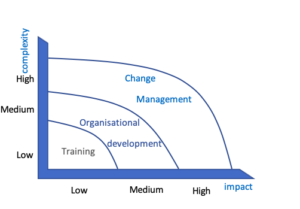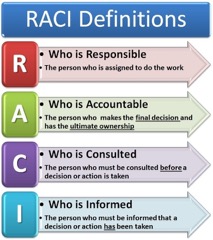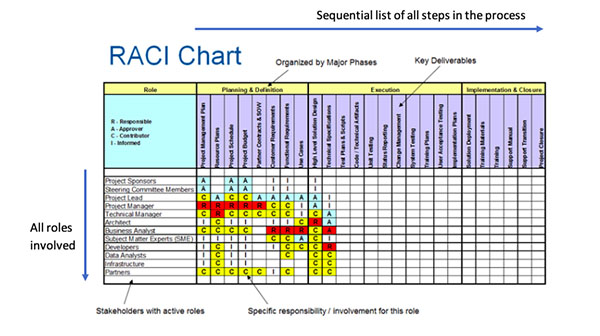
We have demonstrated in “change management part 1: you don’t always need it”, when you need TRAINING. In this article we work on the next step, when training is not enough, and we’ll explain the concepts of organisational development, the RACI model, and the use of change ambassadors or champions.
You don’t always need change management
We already understand: not every change requires “change management”. In the previous blog, we discussed the training related concepts, when your people need to gain KNOWLEDGE, or they need to learn NEW SKILLS, typically is situations of Low impact, Low complexity. We elaborated on the setup of a training, the essential 5 layers, and the exponential training method (Train the trainer).

Medium impact, medium complexity: Organisational Development
What is complexity, and when is it “medium”?
‘In the management arena, the concept of messiness is nothing new to those who practice project management. Whereas the traditional management focuses on things like chains of command, and tying authority to responsibility, project management has centred its attention on getting the job done in an environment where authority is lacking, goals are subject to multiple interpretations, and the rules of behaviour are ill-defined’ (Frame, 2002).
Complicated = not simple, but ultimately knowable (the electrical wiring of an airplane)
Complex = not simple and never fully knowable. Just too many variables interact.
Managing humans will never be complicated. It will always be complex. So no book or diagram or expert is ever going to reveal the truth about managing.
For our purpose:
– the complexity is medium, meaning large parts of your organisation are impacted.
– the impact is medium: it’s more than some procedures, it’s also about what people do, not only how they do it. There is IMPACT on their job, the lines of authority, and the links between departments.
Conclusion: Training alone will not suffice.
Organisational development
If there is impact on the jobs and the structure of the organisation, you need ORGANISATIONAL DEVELOPMENT (often also referred to as “ORGANISATIONAL CHANGE MANAGEMENT”, or “ORGANISATIONAL DESIGN”). You start Organisational Development by charting the TO BE end to end process. Make sure you capture all differences with the current process(es), and describe them clearly. The MYPS process management approach can be used as a tool to capture & document the organisational changes. We will make sure we provide you with some interesting insights on this topic in one of our future Blog’s. ????
Second, define the RACI of all people involved, based on these new processes.
Having agreed RACI’s, provides coordination and clarification of the role (s) and responsibilities of those involved, increases people’s support, it encourages teamwork, it empowers people, stimulates ownership and avoids tasks being duplicated – or forgotten.
RACI is a four letter acronym, describing the 4 major roles is any task:

For completeness’ sake, there are variants to this model: RASCI, that adds the “S” (supporter), or and extra I, where we have “I” for “informed before” and an “I” for Informed after”. Those are less relevant; stick to the one described above. Make sure there is ONLY 1 “A”. It’s very important to have exactly 1 person who is ultimately accountable for the task; as a figure of speech: his/her head is on the block! That doesn’t mean he needs to do all the work – he can make sure there is one or more persons Responsible for doing the job, but the A is in charge. For all the subprocesses involved, define what role is A, R, C and I; use a matrix as below:

Thirdly, look at the impact of the change on your people’s jobs. Describe the current state and the future state, and define the differences. To overcome them technically, include training.
The fourth step is compiling all the impacts and differences, and mapping them to the entire end to end process. Make sure there are no gaps in the process, and enough capacity (people) to execute the process. This will be an iterative process, until you have all the changes to people’s jobs, whilst still covering the entire process.
Incorporate all the above findings in the new job descriptions.
Now, step 5, identify the names for each role. I assume you’ve done this from the start, if the organisation is not too large, but it’s important to match roles and people here.
It might look complicated – and daunting at times- but at the end – step 6- you’ll be able to clearly describe the new processes, the new RACI and roles of all involved, the resulting consequences, impacts on the structure of the organisation, resulting in the required actions to get there. That’s your “organisational development plan”!
When it’s complex and complicated, we enter the Change management arena. We’ll elaborate this in part 3. Change management: when you do need it!

We have demonstrated in “change management part 1: you don’t always need it”, when you need TRAINING. In this article we work on the next step, when training is not enough, and we’ll explain the concepts of organisational development, the RACI model, and the use of change ambassadors or champions.
You don’t always need change management
We already understand: not every change requires “change management”. In the previous blog, we discussed the training related concepts, when your people need to gain KNOWLEDGE, or they need to learn NEW SKILLS, typically is situations of Low impact, Low complexity. We elaborated on the setup of a training, the essential 5 layers, and the exponential training method (Train the trainer).

Medium impact, medium complexity: Organisational Development
What is complexity, and when is it “medium”?
‘In the management arena, the concept of messiness is nothing new to those who practice project management. Whereas the traditional management focuses on things like chains of command, and tying authority to responsibility, project management has centred its attention on getting the job done in an environment where authority is lacking, goals are subject to multiple interpretations, and the rules of behaviour are ill-defined’ (Frame, 2002).
Complicated = not simple, but ultimately knowable (the electrical wiring of an airplane)
Complex = not simple and never fully knowable. Just too many variables interact.
Managing humans will never be complicated. It will always be complex. So no book or diagram or expert is ever going to reveal the truth about managing.
For our purpose:
– the complexity is medium, meaning large parts of your organisation are impacted.
– the impact is medium: it’s more than some procedures, it’s also about what people do, not only how they do it. There is IMPACT on their job, the lines of authority, and the links between departments.
Conclusion: Training alone will not suffice.
Organisational development
If there is impact on the jobs and the structure of the organisation, you need ORGANISATIONAL DEVELOPMENT (often also referred to as “ORGANISATIONAL CHANGE MANAGEMENT”, or “ORGANISATIONAL DESIGN”). You start Organisational Development by charting the TO BE end to end process. Make sure you capture all differences with the current process(es), and describe them clearly. The MYPS process management approach can be used as a tool to capture & document the organisational changes. We will make sure we provide you with some interesting insights on this topic in one of our future Blog’s. ????
Second, define the RACI of all people involved, based on these new processes.
Having agreed RACI’s, provides coordination and clarification of the role (s) and responsibilities of those involved, increases people’s support, it encourages teamwork, it empowers people, stimulates ownership and avoids tasks being duplicated – or forgotten.
RACI is a four letter acronym, describing the 4 major roles is any task:

For completeness’ sake, there are variants to this model: RASCI, that adds the “S” (supporter), or and extra I, where we have “I” for “informed before” and an “I” for Informed after”. Those are less relevant; stick to the one described above. Make sure there is ONLY 1 “A”. It’s very important to have exactly 1 person who is ultimately accountable for the task; as a figure of speech: his/her head is on the block! That doesn’t mean he needs to do all the work – he can make sure there is one or more persons Responsible for doing the job, but the A is in charge. For all the subprocesses involved, define what role is A, R, C and I; use a matrix as below:
Thirdly, look at the impact of the change on your people’s jobs. Describe the current state and the future state, and define the differences. To overcome them technically, include training.
The fourth step is compiling all the impacts and differences, and mapping them to the entire end to end process. Make sure there are no gaps in the process, and enough capacity (people) to execute the process. This will be an iterative process, until you have all the changes to people’s jobs, whilst still covering the entire process.
Incorporate all the above findings in the new job descriptions.
Now, step 5, identify the names for each role. I assume you’ve done this from the start, if the organisation is not too large, but it’s important to match roles and people here.
It might look complicated – and daunting at times- but at the end – step 6- you’ll be able to clearly describe the new processes, the new RACI and roles of all involved, the resulting consequences, impacts on the structure of the organisation, resulting in the required actions to get there. That’s your “organisational development plan”!
When it’s complex and complicated, we enter the Change management arena. We’ll elaborate this in part 3. Change management: when you do need it!


